Aleksey Shipilёv, @shipilev, aleksey@shipilev.net
Thanks to Claes Redestad, Brian Goetz, Ilya Teterin, Yurii Lahodiuk, Gleb Smirnov, Tim Ellison, Stuart Marks, Marshall Pierce, Fabian Lange and others for reviews and helpful suggestions!
Introduction
The Java Language and JDK Class Library have two distinct, yet connected, ways to group elements: arrays and Collections. There are pros and cons for using either one, so both are prevalent in real programs. To aid conversion between the two, there are standard methods to make a reference array appear as a Collection (e.g. Arrays.asList), and to copy from Collection to array (e.g. several Collection.toArray methods). In this post, we will try to answer a controversial question: which toArray conversion pattern is faster?
The post uses JMH as the research crucible. If you haven’t learned about it yet, and/or haven’t looked through the JMH samples, I suggest you do that before reading the rest of this post for the best experience. Some x86 assembly knowledge is also helpful, though not strictly required.
| This post is long and may be very tough for beginners, because it touches on many different things, and has several subflows. I could have split it into the several posts, but I tried, and it turned out messy. If you start to lose a flow, bookmark the post, and resume reading after some rest! |
API Design
It seems very natural to call toArray blindly on a Collection, and/or follow whatever advice we can find with tools, or with frantic internet searches. But if we look at the Collection.toArray family of methods, we can see two separate methods:
public interface Collection<E> extends Iterable<E> {
/**
* Returns an array containing all of the elements in this collection.
*
* ...
*
* @return an array containing all of the elements in this collection
*/
Object[] toArray();
/**
* Returns an array containing all of the elements in this collection;
* the runtime type of the returned array is that of the specified array.
* If the collection fits in the specified array, it is returned therein.
* Otherwise, a new array is allocated with the runtime type of the
* specified array and the size of this collection.
*
* ...
*
* @param <T> the runtime type of the array to contain the collection
* @param a the array into which the elements of this collection are to be
* stored, if it is big enough; otherwise, a new array of the same
* runtime type is allocated for this purpose.
* @return an array containing all of the elements in this collection
* @throws ArrayStoreException if the runtime type of the specified array
* is not a supertype of the runtime type of every element in
* this collection
*/
<T> T[] toArray(T[] a);
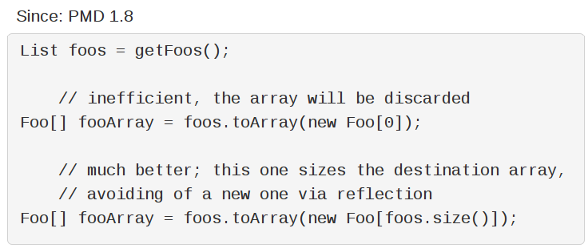
These methods behave subtly differently, and for a reason. The impedance caused by type erasure in generics forces us to spell out the target array type exactly using the actual argument. Note that simply casting the Object[] returned from toArray() to ConcreteType[] would not work, because the runtime has to maintain type safety — trying to cast the array like that will result in a ClassCastException. This secures from a malicious code that could try to circumvent type safety by putting something non-ConcreteType into that Object[] array.
The array-accepting method can also be used to pass through a pre-allocated array in which to put the results. In fact, the wisdom of the ancients might be trying to tell us we are much better off providing the pre-sized array (may be even zero-sized!), for best performance. IntelliJ IDEA 15 suggests passing the pre-sized array, instead of being lazy and passing a zero-sized array. It goes on to explain that a library would have to do a reflection call to allocate the array of a given runtime type, and that apparently costs you.
PMD’s OptimizableToArrayCall rule tells us the same, but also seems to imply that a newly-allocated "empty" array would be discarded, and we should avoid that by passing a pre-sized destination array.
How smart are the ancients really?
Performance Runs
Experimental Setup
Before we conduct the experiment, we need to understand the degrees of freedom. There are at least three to consider:
-
Collection size. PMD’s rule suggests that allocating the array that is going to be discarded is futile. This means we want to cover a number of small collection sizes to see the impact of "gratuitous" array instantiations. We would also like to see how large collections perform, when we would expect element copying costs to dominate. Naturally, we want to prod the sizes in between in order to avoid "performance sweet spots".
-
toArray() argument shapes. Of course, we want to try all variants of
toArraycalls. The particular interest is the zero-sized-array call vs. the presized-array call, but a non-typedtoArrayis also interesting as a reference. -
toArray() implementations in Collections. IDEA suggests there is a possible reflective array instantiation that costs performance. We need to investigate what collections are actually using. Most collections do the same as
AbstractCollection: allocate either anObject[]or aT[]array — in the latter case, indeed, allocating theT[]array using thejava.lang.reflect.Array::newInstancemethod — then picking up the iterator, and copying the elements one-by-one into the destination array.public abstract class AbstractCollection { public <T> T[] toArray(T[] a) { int size = size(); T[] r = (a.length >= size) ? a : (T[])Array.newInstance(a.getClass().getComponentType(), size); Iterator<E> it = iterator(); for (int i = 0; i < r.length; i++) { ... r[i] = (T)it.next(); } return ... r; } }Some collections, notably
ArrayList, simply copy their backing array storage to the destination array:public class ArrayList { public <T> T[] toArray(T[] a) { if (a.length < size) { // Arrays.copyOf would do the Array.newInstance return (T[]) Arrays.copyOf(elementData, size, a.getClass()); } System.arraycopy(elementData, 0, a, 0, size); if (a.length > size) { a[size] = null; } return a; } }ArrayListis one of the most frequently used collection classes, and so we would want to see how both a ubiquitousArrayList, and a generic,AbstractCollection-backed collection likeHashSetperform.
Benchmark
With the observations from above, we can construct the following JMH benchmark:
@Warmup(iterations = 5, time = 1, timeUnit = TimeUnit.SECONDS)
@Measurement(iterations = 5, time = 1, timeUnit = TimeUnit.SECONDS)
@Fork(value = 3, jvmArgsAppend = {"-XX:+UseParallelGC", "-Xms1g", "-Xmx1g"})
@BenchmarkMode(Mode.AverageTime)
@OutputTimeUnit(TimeUnit.NANOSECONDS)
@State(Scope.Benchmark)
public class ToArrayBench {
@Param({"0", "1", "10", "100", "1000"})
int size;
@Param({"arraylist", "hashset"})
String type;
Collection<Foo> coll;
@Setup
public void setup() {
if (type.equals("arraylist")) {
coll = new ArrayList<Foo>();
} else if (type.equals("hashset")) {
coll = new HashSet<Foo>();
} else {
throw new IllegalStateException();
}
for (int i = 0; i < size; i++) {
coll.add(new Foo(i));
}
}
@Benchmark
public Object[] simple() {
return coll.toArray();
}
@Benchmark
public Foo[] zero() {
return coll.toArray(new Foo[0]);
}
@Benchmark
public Foo[] sized() {
return coll.toArray(new Foo[coll.size()]);
}
public static class Foo {
private int i;
public Foo(int i) {
this.i = i;
}
@Override
public boolean equals(Object o) {
if (this == o) return true;
if (o == null || getClass() != o.getClass()) return false;
Foo foo = (Foo) o;
return i == foo.i;
}
@Override
public int hashCode() {
return i;
}
}
}
Since this benchmark is GC-intensive, it is important to fix the GC algorithm and heap sizes to avoid surprises with heuristics that may change behavior unexpectedly. This is especially important for comparisons between JDK versions, and for benchmarks that incur lots of allocations. Note how we lock down Parallel GC, with static 1 Gb heap with a @Fork annotation above.
|
Performance Data
Running on quite a large i7-4790K, 4.0 GHz, Linux x86_64, JDK 9b99 EA, will yield (average execution time, the lower the better):
Benchmark (size) (type) Mode Cnt Score Error Units
# ---------------------------------------------------------------------------
ToArrayBench.simple 0 arraylist avgt 30 19.445 ± 0.152 ns/op
ToArrayBench.sized 0 arraylist avgt 30 19.009 ± 0.252 ns/op
ToArrayBench.zero 0 arraylist avgt 30 4.590 ± 0.023 ns/op
ToArrayBench.simple 1 arraylist avgt 30 7.906 ± 0.024 ns/op
ToArrayBench.sized 1 arraylist avgt 30 18.972 ± 0.357 ns/op
ToArrayBench.zero 1 arraylist avgt 30 10.472 ± 0.038 ns/op
ToArrayBench.simple 10 arraylist avgt 30 8.499 ± 0.049 ns/op
ToArrayBench.sized 10 arraylist avgt 30 24.637 ± 0.128 ns/op
ToArrayBench.zero 10 arraylist avgt 30 15.845 ± 0.075 ns/op
ToArrayBench.simple 100 arraylist avgt 30 40.874 ± 0.352 ns/op
ToArrayBench.sized 100 arraylist avgt 30 93.170 ± 0.379 ns/op
ToArrayBench.zero 100 arraylist avgt 30 80.966 ± 0.347 ns/op
ToArrayBench.simple 1000 arraylist avgt 30 400.130 ± 2.261 ns/op
ToArrayBench.sized 1000 arraylist avgt 30 908.007 ± 5.869 ns/op
ToArrayBench.zero 1000 arraylist avgt 30 673.682 ± 3.586 ns/op
# ---------------------------------------------------------------------------
ToArrayBench.simple 0 hashset avgt 30 21.270 ± 0.424 ns/op
ToArrayBench.sized 0 hashset avgt 30 20.815 ± 0.400 ns/op
ToArrayBench.zero 0 hashset avgt 30 4.354 ± 0.014 ns/op
ToArrayBench.simple 1 hashset avgt 30 22.969 ± 0.221 ns/op
ToArrayBench.sized 1 hashset avgt 30 23.752 ± 0.503 ns/op
ToArrayBench.zero 1 hashset avgt 30 23.732 ± 0.076 ns/op
ToArrayBench.simple 10 hashset avgt 30 39.630 ± 0.613 ns/op
ToArrayBench.sized 10 hashset avgt 30 43.808 ± 0.629 ns/op
ToArrayBench.zero 10 hashset avgt 30 44.192 ± 0.823 ns/op
ToArrayBench.simple 100 hashset avgt 30 298.032 ± 3.925 ns/op
ToArrayBench.sized 100 hashset avgt 30 316.250 ± 9.614 ns/op
ToArrayBench.zero 100 hashset avgt 30 284.431 ± 6.201 ns/op
ToArrayBench.simple 1000 hashset avgt 30 4227.564 ± 84.983 ns/op
ToArrayBench.sized 1000 hashset avgt 30 4539.614 ± 135.379 ns/op
ToArrayBench.zero 1000 hashset avgt 30 4428.601 ± 205.191 ns/op
# ---------------------------------------------------------------------------Okay, it appears that a simple conversion wins over everything else, and, counter-intuitively, zero conversion wins over sized.
| At this point, most people make the major mistake: they run with these numbers as if they are the truth. But these numbers are just data, they don’t mean anything unless we extract the insights out of them. To do that, we need to see why the numbers are like that. |
Looking closely at the data, we want to get the answers on two major questions:
-
Why does
simpleappear faster thanzeroandsized? -
Why does
zeroappear faster thansized?
Answering these questions is the road to understanding what is going on.
| The running exercise for any good performance engineer would be to try to guess the answers before starting the investigation to figure out the actual ones, thus training the intuition. Take a few minutes to come up with plausible hypothetical answers to these questions. What experiments would you have to do to confirm the hypotheses? What experiments would be able to falsify them? |
Not an Allocation Pressure
I’d like to throw out a simple hypothesis though: allocation pressure. One might speculate that different allocation pressures can explain the difference in performance. In fact, many GC-intensive workloads are also GC-bound, meaning the benchmark performance is tidally locked with GC performance.
It is usually easy to turn quite a few benchmarks into GC-bound ones. In our case, we are running the benchmark code with a single thread, which leaves GC threads free to run on separate cores, picking up the single benchmark thread’s garbage with multiple GC threads. Adding more benchmark threads will make them: a) compete with GC threads for CPU time, thus implicitly counting in the GC time, and b) produce much more garbage, so that the effective number of GC threads per application thread goes down, exacerbating the memory management costs.
| This is one of the reasons why you would normally want to run benchmarks in both single-threaded and multi-threaded (saturated) modes. Running in saturated mode captures whatever "hidden" offload activity the system is doing. |
But, in our case, we can take a shortcut and estimate the allocation pressure directly. For that, JMH has the -prof gc profiler, that listens for GC events, adds them up, and normalizes the allocation/churn rates to the number of benchmark ops, giving you the allocation pressure per @Benchmark call.
Benchmark (size) (type) Mode Cnt Score Error Units
# ------------------------------------------------------------------------
ToArrayBench.simple 0 arraylist avgt 30 16.000 ± 0.001 B/op
ToArrayBench.sized 0 arraylist avgt 30 16.000 ± 0.001 B/op
ToArrayBench.zero 0 arraylist avgt 30 16.000 ± 0.001 B/op
ToArrayBench.simple 1 arraylist avgt 30 24.000 ± 0.001 B/op
ToArrayBench.sized 1 arraylist avgt 30 24.000 ± 0.001 B/op
ToArrayBench.zero 1 arraylist avgt 30 40.000 ± 0.001 B/op
ToArrayBench.simple 10 arraylist avgt 30 56.000 ± 0.001 B/op
ToArrayBench.sized 10 arraylist avgt 30 56.000 ± 0.001 B/op
ToArrayBench.zero 10 arraylist avgt 30 72.000 ± 0.001 B/op
ToArrayBench.simple 100 arraylist avgt 30 416.000 ± 0.001 B/op
ToArrayBench.sized 100 arraylist avgt 30 416.000 ± 0.001 B/op
ToArrayBench.zero 100 arraylist avgt 30 432.000 ± 0.001 B/op
ToArrayBench.simple 1000 arraylist avgt 30 4016.001 ± 0.001 B/op
ToArrayBench.sized 1000 arraylist avgt 30 4016.001 ± 0.002 B/op
ToArrayBench.zero 1000 arraylist avgt 30 4032.001 ± 0.001 B/op
# ------------------------------------------------------------------------
ToArrayBench.simple 0 hashset avgt 30 16.000 ± 0.001 B/op
ToArrayBench.sized 0 hashset avgt 30 16.000 ± 0.001 B/op
ToArrayBench.zero 0 hashset avgt 30 16.000 ± 0.001 B/op
ToArrayBench.simple 1 hashset avgt 30 24.000 ± 0.001 B/op
ToArrayBench.sized 1 hashset avgt 30 24.000 ± 0.001 B/op
ToArrayBench.zero 1 hashset avgt 30 24.000 ± 0.001 B/op
ToArrayBench.simple 10 hashset avgt 30 56.000 ± 0.001 B/op
ToArrayBench.sized 10 hashset avgt 30 56.000 ± 0.001 B/op
ToArrayBench.zero 10 hashset avgt 30 56.000 ± 0.001 B/op
ToArrayBench.simple 100 hashset avgt 30 416.000 ± 0.001 B/op
ToArrayBench.sized 100 hashset avgt 30 416.001 ± 0.001 B/op
ToArrayBench.zero 100 hashset avgt 30 416.001 ± 0.001 B/op
ToArrayBench.simple 1000 hashset avgt 30 4056.006 ± 0.009 B/op
ToArrayBench.sized 1000 hashset avgt 30 4056.007 ± 0.010 B/op
ToArrayBench.zero 1000 hashset avgt 30 4056.006 ± 0.009 B/op
# ------------------------------------------------------------------------The data indeed show that allocation pressure is mostly the same within the same size. zero tests are allocating 16 bytes more in some cases — that’s the cost for "redundant" array allocation. (Exercise for the readers: why it is the same for zero with hashset cases?). But, our throughput benchmarks above suggests that zero cases are faster, not slower, as the allocation pressure hypothesis would predict. Therefore, allocation pressure cannot be the explanation for the phenomenon we are seeing.
Performance Analysis
In our field, we can skip the hypotheses building and go straight to poking the stuff with power tools. This section could be shorter, if we used hindsight, and breezed straight to the conclusion. But one of the points for this post is to show off the approaches one can take to analyze these benchmarks.
Meet VisualVM (and other Java-only profilers)
The most obvious approach is to attach a Java profiler to the benchmarked JVM, and see what is going on there. Without loss of generality, let’s take the VisualVM profiler that is shipped with JDK itself, and thus readily available on most installations.
It is very easy to use: start the application, start VisualVM (if the JDK is in your PATH, then invoking jvisualvm is enough), select a target VM from the list, select "Sample" from a drop-down list or a tab, press the "CPU Sampling" button, and enjoy the results. Let’s take one of our tests and see what it shows us:
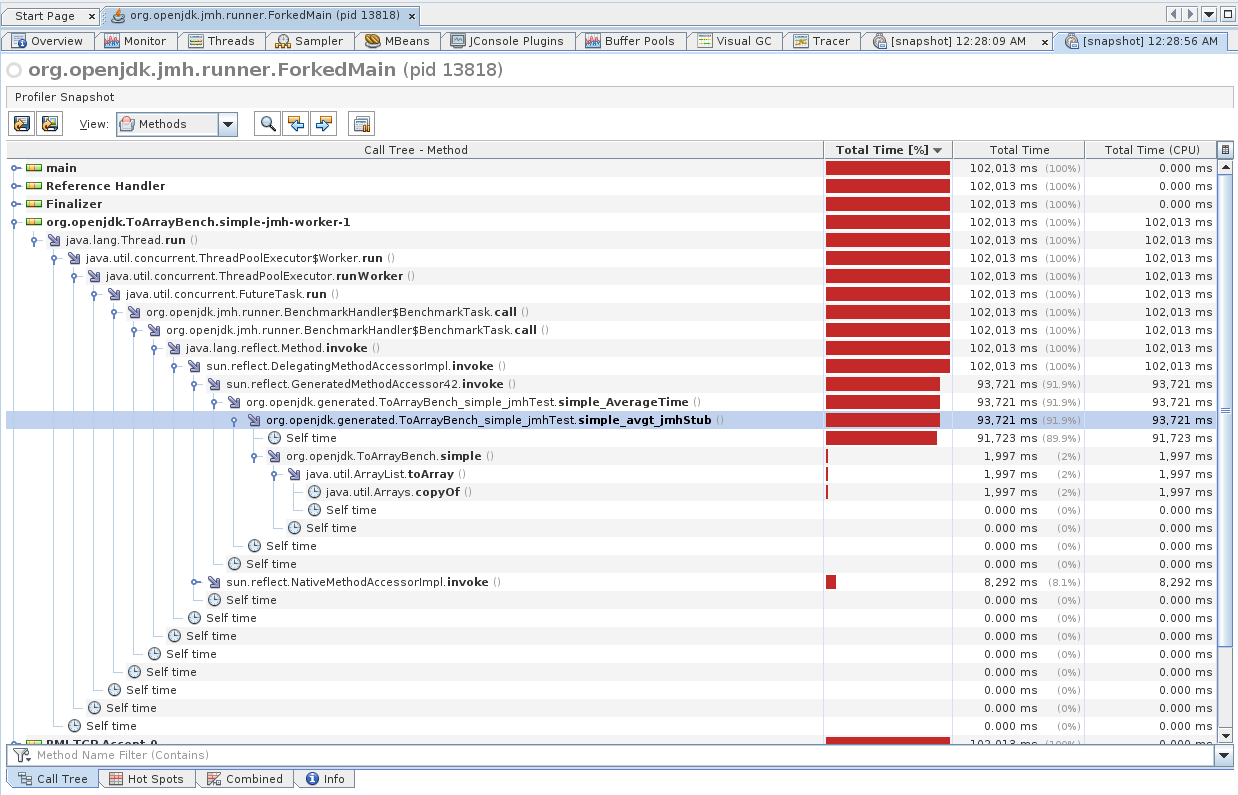
Err… Very informative.
Most Java profilers are inherently biased, because they either instrument the code and thus offset the real results, or they sample at designated places in the code (e.g. safepoints) that also skews the results. In our case above, while the bulk of work is done in simple() method, profiler misattributes the work to …_jmhStub method that holds the benchmark loop.
But this is not the central issue here. The most problematic part for us is the absence of any low-level details that may help us to answer performance questions. Can you see anything in the profiling snapshot above that can verify any sensible hypothesis in our case? You cannot, because the data is too coarse. Note that this is not an issue for larger workloads where performance phenomena manifest in larger and more distributed call trees. In those workloads, bias effects are smoothed out.
Meet JMH -prof perfasm
The need to explore low-level details for microbenchmarks is the reason why good microbenchmark harnesses provide a clear-cut way to profile, analyze, and introspect tiny workloads. In case of JMH, we have the embedded "perfasm" profiler that dumps PrintAssembly output from the VM, annotates it with perf_events counters, and prints out the hottest parts. perf_events provides non-intrusive sampling profiling with hardware counters, which is what we want for fine-grained performance engineering.
Below is the example output for one of the tests:
$ java -jar target/benchmarks.jar zero -f 1 -p size=1000 -p type=arraylist -prof perfasm
....[Hottest Region 1].......................................................................
[0x7fc4c180916e:0x7fc4c180920c] in StubRoutines::checkcast_arraycopy
StubRoutines::checkcast_arraycopy [0x00007fc4c18091a0, 0x00007fc4c180926b]
0.04% 0x00007fc4c18091a0: push %rbp
0.06% 0.01% 0x00007fc4c18091a1: mov %rsp,%rbp
0.01% 0x00007fc4c18091a4: sub $0x10,%rsp
0.02% 0.01% 0x00007fc4c18091a8: mov %r13,(%rsp)
0.14% 0.02% 0x00007fc4c18091ac: mov %r14,0x8(%rsp)
0.07% 0.02% 0x00007fc4c18091b1: lea (%rdi,%rdx,4),%rdi
0.01% 0x00007fc4c18091b5: lea (%rsi,%rdx,4),%r13
0x00007fc4c18091b9: mov %rdx,%r14
0.02% 0x00007fc4c18091bc: neg %rdx
0.01% 0.01% ╭ 0x00007fc4c18091bf: jne 0x00007fc4c18091de
│ 0x00007fc4c18091c5: xor %rax,%rax
│ 0x00007fc4c18091c8: jmpq 0x00007fc4c1809260
│ 0x00007fc4c18091cd: data16 xchg %ax,%ax
19.30% 19.73% │↗↗↗ 0x00007fc4c18091d0: mov %eax,0x0(%r13,%rdx,4)
5.96% 6.89% ││││ 0x00007fc4c18091d5: inc %rdx
││││ 0x00007fc4c18091d8: je 0x00007fc4c1809233
3.84% 4.92% ↘│││ 0x00007fc4c18091de: mov (%rdi,%rdx,4),%eax
5.83% 6.56% │││ 0x00007fc4c18091e1: test %rax,%rax
╰││ 0x00007fc4c18091e4: je 0x00007fc4c18091d0
14.88% 20.52% ││ 0x00007fc4c18091e6: mov 0x8(%rax),%r11d
15.11% 19.60% ││ 0x00007fc4c18091ea: shl $0x3,%r11
10.65% 11.80% ││ 0x00007fc4c18091ee: cmp %r8,%r11
0.01% ╰│ 0x00007fc4c18091f1: je 0x00007fc4c18091d0
│ 0x00007fc4c18091f3: cmp (%r11,%rcx,1),%r8
╰ 0x00007fc4c18091f7: je 0x00007fc4c18091d0
0x00007fc4c18091f9: cmp $0x18,%ecx
0x00007fc4c18091fc: jne 0x00007fc4c1809223
0x00007fc4c1809202: push %rax
0x00007fc4c1809203: mov %r8,%rax
0x00007fc4c1809206: push %rcx
0x00007fc4c1809207: push %rdi
0x00007fc4c1809208: mov 0x20(%r11),%rdi
0x00007fc4c180920c: mov (%rdi),%ecx
.............................................................................................
75.96% 90.09% <total for region 1>It shows the hottest part is somewhere in the cryptic StubRoutines::checkcast_arraycopy code block. We would dive in later, but the main takeaway is that our performance phenomena lies somewhere within the generated code, and probably not even from the Java-backed generated code. While the further insights in this post are recoverable with perfasm, I want to focus on another option that is more conventional, and scalable for larger workloads.
Meet Solaris Studio Performance Analyzer
Imagine we want a profiler that combines non-biased Java/native profiling, with optional hardware-counters profiling? There is an app for that! Confusingly, it is called Solaris Studio Performance Analyzer, though it can work on Linux too.
There are a few suitable workflows for the Analyzer, and here is the one we mostly use in our experiments. Analyzer has two distinct parts: a collect tool that collects the performance data, and an analyzer GUI that can be used to process the results. While you can start/attach to a running process from the GUI, having a CLI collect tool is very handy, because you can define a few reusable shell aliases:
$ tail ~/.bashrc
# Collect Java+native, clock profiling
alias 'perfanal'="collect -o test.1.er -S on -j on -A on "
# Collect native only (useful when loading *lots* of classes
# -- avoids profiler's JVMTI hooks overheads), clock profiling
alias 'perfanal-native'="collect -o test.1.er -S on -j off -A on "
# Collect Java+native, hardware counter profiling
alias 'perfanal-hwc'="collect -o test.1.er -S on -j on -A on -h cycles,on,insts,on "
# Collect native only, hardware counting profiling
alias 'perfanal-hwc-native'="collect -o test.1.er -S on -j off -A on -h cycles,on,insts,on "These aliases allow you to quickly attach Analyzer to JMH like this:
$ perfanal-hwc java -jar benchmarks.jar -f 1 -p size=1000 -p type=arraylistThis will create the test.${n}.er result file in your current directory, which you can then open with Analyzer GUI. The GUI is rich enough to understand intuitively, and here is what we see in it.

In a simple case, we see the hottest function is jint_disjoint_arraycopy, which seems to be the function that implements an "int" arraycopy for disjoint arrays.
Note how the profiler resolved both Java code (org.openjdk…), VM native code (ParallelTaskTerminator::… and SpinPause), and generated VM stubs (e.g. jint_disjoint_arraycopy). In complex scenarios, call trees would show both Java and native frames, which is immensely helpful when debugging JNI/JNA cases, including calls into the VM itself.
|
The "Call Tree" would show you that this jint_disjoint_arraycopy is a leaf function. There is no other indication as to what this function is, but you can search around in Hotspot source base, then you will stumble upon stubRoutines.hpp, which will say that "StubRoutines provides entry points to assembly routines used by compiled code and the run-time system. Platform-specific entry points are defined in the platform-specific inner class." Both compiler and runtime use that to optimize some operations, notably arraycopy.
|

In a sized case, we see a different function for arraycopy, checkcast_arraycopy, plus the Java code for sized() method.

In a zero case, we see yet another contender, checkcast_arraycopy_uninit, which looks like a modification of checkcast_arraycopy, but "uninitialized"? Notice the Java method is gone from hotspots.
Well, the function names are already quite revealing, but it would be only an educated guess until we invoke another outstanding feature of Analyzer. If we select the function from the list (or "Call Tree"), and switch to "Disassembly" view, we will see… wait for it… disassembly!
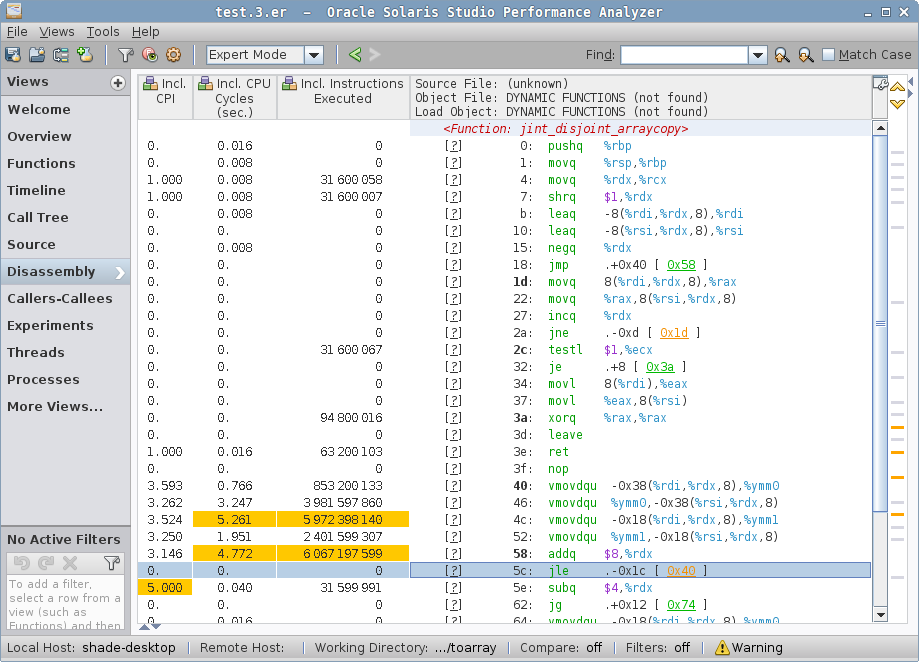
simple case disassembly.The jint_disjoint_arraycopy is indeed the copying stub, which employs AVX for vectorized copy! No wonder this thing is fast: it copies the backing storage in large strides.
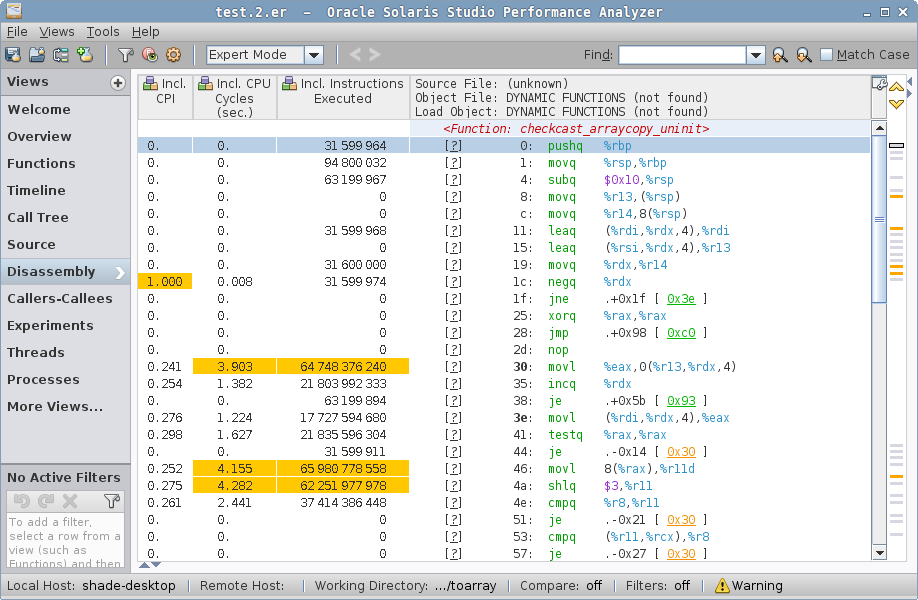
zero case disassemblyzero case disassembly shows non-vectorized checkcast_arraycopy_uninit. What does it do? The loop at relative addresses 30-51 is indeed copying, but it does not seem to be vectorized at all. Alas, deciphering what it does requires some VM internals knowledge. Normally, you will be able to attach the Java code to assembly, but VM stubs have no Java code associated with them. You can also trace the VM source code that generated the stub. Here, we will just stare patiently at the code.
The loop reads with movl(%rdi,%rdx,4),%eax and writes with movl %eax, 0(%r13,%rdx,4), and %rdx is increasing — it follows from that %rdx is the loop counter. After reading the current element to %eax, we null-check it, load something from offset 0x8, shift it, and compare with something else. That is loading a class word, unpacking it, and doing the typecheck against it.
| You can peek around the runtime representation of Java Objects with JOL. Notably, see the JOLSample_11_ClassWord example. |
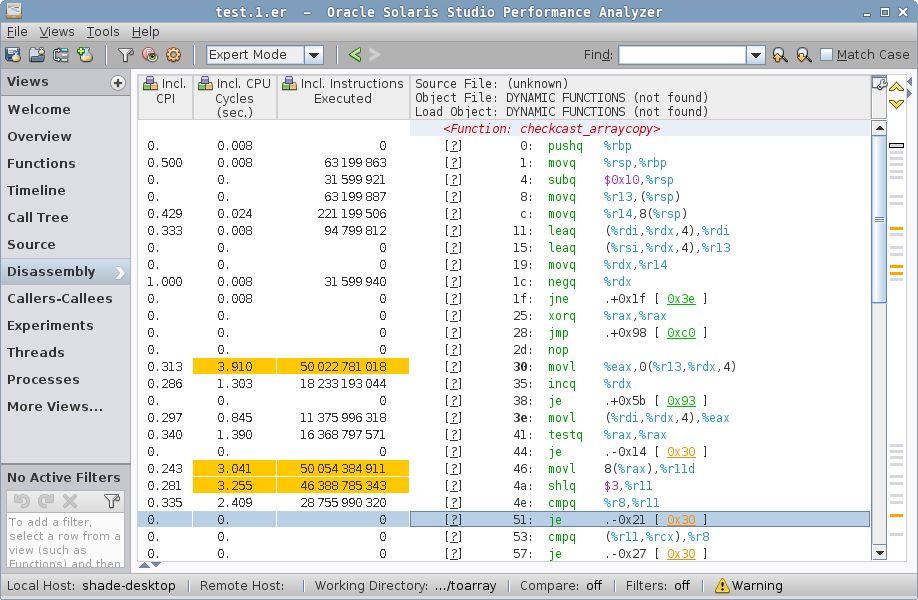
sized case disassembly, arraycopy stubsized has two hotspots, one in checkcast_arraycopy, where the hot loop is actually the same as in zero case above, but then we come to a second hotspot:
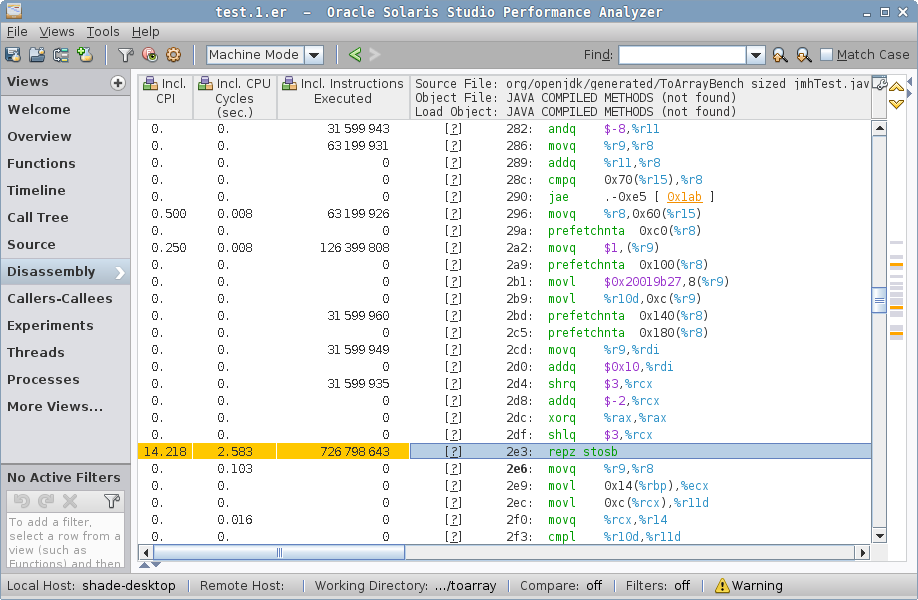
sized case disassembly, Java code…which attributes most cycles to the repz stosb instruction. This is cryptic until you look around the generated code. prefetchnta instructions in HotSpot-generated code usually attributes to "allocation prefetch" (see command line docs, "-XX:Allocate…"), which is tied to object allocation. In fact, we have the "new" object address in %r9, and we put the mark word, class word, and then zero the storage with repz stosb — that’s a "memset to zero" in disguise. The allocation itself is an array allocation, and what we see is the array zeroing. You can read about this in greater detail in "Why Nothing Matters: The Impact of Zeroing".
Preliminaries
With that, we have our preliminary insights:
-
Vectorized arraycopy in the
simplecase is much faster than type-checked arraycopy insizedandzero. -
Magically dodging the array zeroing lets
zerobecome faster thansized. "Reflective" array creation does not seem to affectzerocase at all.
Redoing the same for HashSet is left as the exercise to the reader: it will bring roughly the same preliminary answers.
Follow-Ups
In way too many cases, it is instructive and educational to follow up on the findings you just got from a targeted workload, in order to see how general the conclusions are, and whether you understand them well. Beware, this is the Rabbit Hole of Performance Engineering — you cannot finish the dive, you can only stop it.
New Reflective Array
First, let us deconstruct the "reflective array creation is slow" sentiment. We know that many collections instantiate the arrays of a given type with Array.newInstance(Class<?>,int) — why don’t we give it a try? Let’s see, having the same benchmarking ideas in mind, let us strip away everything except the newInstance call:
@Warmup(iterations = 10, time = 1, timeUnit = TimeUnit.SECONDS)
@Measurement(iterations = 10, time = 1, timeUnit = TimeUnit.SECONDS)
@Fork(value = 3, jvmArgsAppend = {"-XX:+UseParallelGC", "-Xms1g", "-Xmx1g"})
@BenchmarkMode(Mode.AverageTime)
@OutputTimeUnit(TimeUnit.NANOSECONDS)
@State(Scope.Benchmark)
public class ReflectiveArrayBench {
@Param({"0", "1", "10", "100", "1000"})
int size;
@Benchmark
public Foo[] lang() {
return new Foo[size];
}
@Benchmark
public Foo[] reflect() {
return (Foo[]) Array.newInstance(Foo.class, size);
}
}Now, if you look into the performance data, you’ll notice that the performance is the same for both "language" expression for array instantiation and the reflective call:
Benchmark (size) Mode Cnt Score Error Units
# default
ReflectiveArrayBench.lang 0 avgt 5 17.065 ± 0.224 ns/op
ReflectiveArrayBench.lang 1 avgt 5 12.372 ± 0.112 ns/op
ReflectiveArrayBench.lang 10 avgt 5 14.910 ± 0.850 ns/op
ReflectiveArrayBench.lang 100 avgt 5 42.942 ± 3.666 ns/op
ReflectiveArrayBench.lang 1000 avgt 5 267.889 ± 15.719 ns/op
# default
ReflectiveArrayBench.reflect 0 avgt 5 17.010 ± 0.299 ns/op
ReflectiveArrayBench.reflect 1 avgt 5 12.542 ± 0.322 ns/op
ReflectiveArrayBench.reflect 10 avgt 5 12.835 ± 0.587 ns/op
ReflectiveArrayBench.reflect 100 avgt 5 42.691 ± 2.204 ns/op
ReflectiveArrayBench.reflect 1000 avgt 5 264.408 ± 22.079 ns/opWhy is that? Where’s my expensive reflection call? To cut the chase short, you can usually do these steps to bisect this "oddity". First, google/remember that for a long time Reflection calls get "inflated" (the transition from JNI, which has larger per-call cost but avoids one-time setup, to faster JNI-free generated code once an invocation threshold is hit). Turn off Reflection inflation:
Benchmark (size) Mode Cnt Score Error Units
# -Dsun.reflect.inflationThreshold=2147483647
ReflectiveArrayBench.reflect 0 avgt 10 17.253 ± 0.470 ns/op
ReflectiveArrayBench.reflect 1 avgt 10 12.418 ± 0.101 ns/op
ReflectiveArrayBench.reflect 10 avgt 10 12.554 ± 0.109 ns/op
ReflectiveArrayBench.reflect 100 avgt 10 39.969 ± 0.367 ns/op
ReflectiveArrayBench.reflect 1000 avgt 10 252.281 ± 2.630 ns/opHm, well, that’s not it. Let’s dig into the source code:
class Array {
public static Object newInstance(Class<?> componentType, int length)
throws NegativeArraySizeException {
return newArray(componentType, length);
}
@HotSpotIntrinsicCandidate // <--- Ohh, what's this?
private static native Object newArray(Class<?> componentType, int length)
throws NegativeArraySizeException;
}/**
* The {@code @HotSpotIntrinsicCandidate} annotation is specific to the
* HotSpot Virtual Machine. It indicates that an annotated method
* may be (but is not guaranteed to be) intrinsified by the HotSpot VM. A method
* is intrinsified if the HotSpot VM replaces the annotated method with hand-written
* assembly and/or hand-written compiler IR -- a compiler intrinsic -- to improve
* performance. The {@code @HotSpotIntrinsicCandidate} annotation is internal to the
* Java libraries and is therefore not supposed to have any relevance for application
* code.
*/
public @interface HotSpotIntrinsicCandidate { ... }So, the Array.newArray method is known to the VM. Interesting, let’s see under what name:
do_intrinsic(_newArray, java_lang_reflect_Array, newArray_name, newArray_signature, F_SN) \
do_name( newArray_name, "newArray") \
do_signature(newArray_signature, "(Ljava/lang/Class;I)Ljava/lang/Object;") \Intrinsic, eh? Let me try to disable you:
# -XX:+UnlockDiagnosticVMOptions -XX:DisableIntrinsic=_newArray
ReflectiveArrayBench.reflect 0 avgt 5 67.594 ± 4.795 ns/op
ReflectiveArrayBench.reflect 1 avgt 5 69.935 ± 7.766 ns/op
ReflectiveArrayBench.reflect 10 avgt 5 73.588 ± 0.329 ns/op
ReflectiveArrayBench.reflect 100 avgt 5 86.598 ± 1.735 ns/op
ReflectiveArrayBench.reflect 1000 avgt 5 409.786 ± 9.148 ns/opAha, there! This is handled specifically by the JVM, and the same generated code is emitted. But, don’t ever assume any "fancy" option you have seen on the Internet does what you think it does. Let us take the profile in Performance Analyzer:
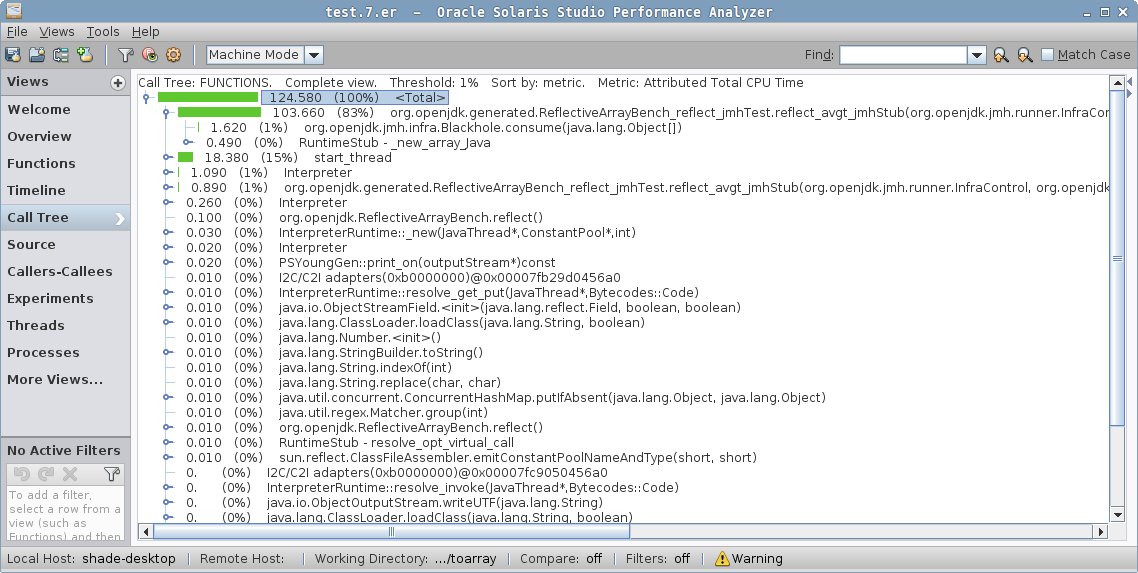
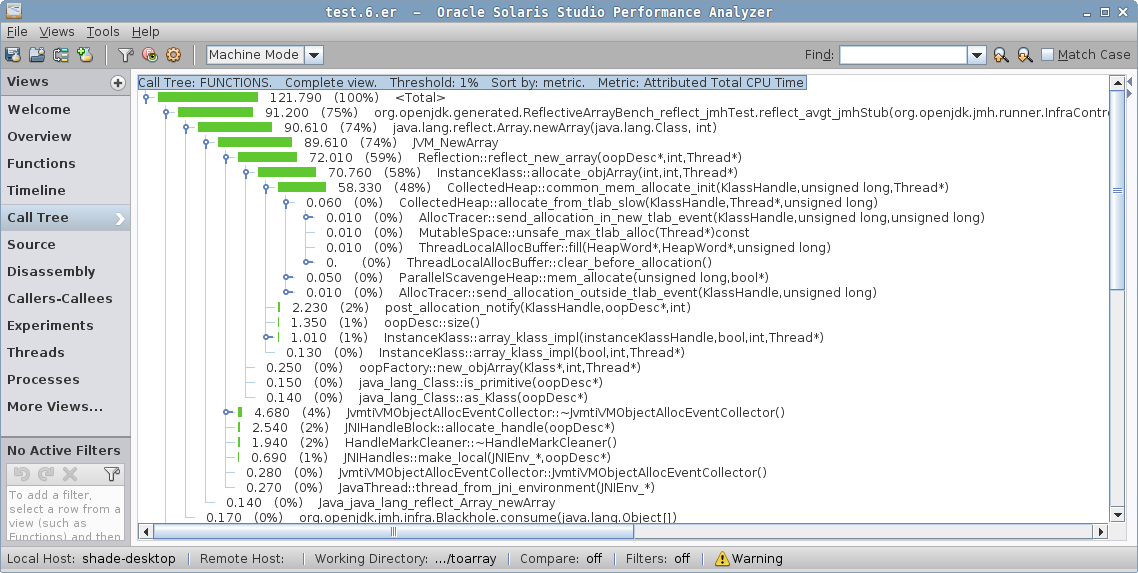
See the difference? When the intrinsic is disabled, we have the Java method for Array.newArray, then a call to the JVM_NewArray native method implementation, which then calls the VM’s Reflection::…, and goes from there to the GC asking to allocate the array. This must be what people have seen as an expensive "Array.newArray call".
But, that is not true anymore. JIRA archeology points at JDK-6525802 as the fix. We’ll explore historical performance data later.
Empty Array Instantiation
Now, let’s shift attention to array instantiation costs. It is important to understand how the allocation itself works before we jump to zeroing elimination. In hindsight, we would want to measure both constant sized arrays, and non-constant sized arrays where the array size is not statically known. Can the compiler do something with that knowledge?
Let’s see, and build the JMH benchmark like this (I describe it in a pseudo-macro-language to make it shorter):
@Warmup(iterations = 10, time = 1, timeUnit = TimeUnit.SECONDS)
@Measurement(iterations = 10, time = 1, timeUnit = TimeUnit.SECONDS)
@Fork(value = 3, jvmArgsAppend = {"-XX:+UseParallelGC", "-Xms1g", "-Xmx1g"})
@BenchmarkMode(Mode.AverageTime)
@OutputTimeUnit(TimeUnit.NANOSECONDS)
@State(Scope.Benchmark)
public class EmptyArrayBench {
#for L in 0..512
int v$L = $L;
@Benchmark
public Foo[] field_$L() {
return new Foo[v$L];
}
@Benchmark
public Foo[] const_$L() {
return new Foo[$L];
}
#done
}Running this benchmark would yield something like:
Benchmark Mode Cnt Score Error Units
# -----------------------------------------------------------
EmptyArrayBench.const_000 avgt 15 2.847 ± 0.016 ns/op
EmptyArrayBench.const_001 avgt 15 3.090 ± 0.020 ns/op
EmptyArrayBench.const_002 avgt 15 3.083 ± 0.022 ns/op
EmptyArrayBench.const_004 avgt 15 3.336 ± 0.029 ns/op
EmptyArrayBench.const_008 avgt 15 4.618 ± 0.047 ns/op
EmptyArrayBench.const_016 avgt 15 7.568 ± 0.061 ns/op
EmptyArrayBench.const_032 avgt 15 13.935 ± 0.098 ns/op
EmptyArrayBench.const_064 avgt 15 25.905 ± 0.183 ns/op
EmptyArrayBench.const_128 avgt 15 52.807 ± 0.252 ns/op
EmptyArrayBench.const_256 avgt 15 110.208 ± 1.006 ns/op
EmptyArrayBench.const_512 avgt 15 171.864 ± 0.777 ns/op
# -----------------------------------------------------------
EmptyArrayBench.field_000 avgt 15 16.998 ± 0.063 ns/op
EmptyArrayBench.field_001 avgt 15 12.400 ± 0.065 ns/op
EmptyArrayBench.field_002 avgt 15 12.651 ± 0.332 ns/op
EmptyArrayBench.field_004 avgt 15 12.434 ± 0.062 ns/op
EmptyArrayBench.field_008 avgt 15 12.504 ± 0.049 ns/op
EmptyArrayBench.field_016 avgt 15 12.588 ± 0.065 ns/op
EmptyArrayBench.field_032 avgt 15 14.423 ± 0.121 ns/op
EmptyArrayBench.field_064 avgt 15 26.145 ± 0.166 ns/op
EmptyArrayBench.field_128 avgt 15 53.092 ± 0.291 ns/op
EmptyArrayBench.field_256 avgt 15 110.275 ± 1.304 ns/op
EmptyArrayBench.field_512 avgt 15 174.326 ± 1.642 ns/op
# -----------------------------------------------------------Oops. It would seem that field_* tests lose on small lengths. Why is that? -prof perfasm has a hint:
const_0008: 2.30% 1.07% 0x00007f32cd1f9f76: prefetchnta 0xc0(%r10)
3.34% 3.88% 0x00007f32cd1f9f7e: movq $0x1,(%rax)
3.66% 4.39% 0x00007f32cd1f9f85: prefetchnta 0x100(%r10)
1.63% 1.91% 0x00007f32cd1f9f8d: movl $0x20018fbd,0x8(%rax)
1.76% 2.31% 0x00007f32cd1f9f94: prefetchnta 0x140(%r10)
1.52% 2.14% 0x00007f32cd1f9f9c: movl $0x8,0xc(%rax)
2.77% 3.67% 0x00007f32cd1f9fa3: prefetchnta 0x180(%r10)
1.77% 1.80% 0x00007f32cd1f9fab: mov %r12,0x10(%rax)
4.40% 4.61% 0x00007f32cd1f9faf: mov %r12,0x18(%rax)
4.64% 3.97% 0x00007f32cd1f9fb3: mov %r12,0x20(%rax)
4.83% 4.49% 0x00007f32cd1f9fb7: mov %r12,0x28(%rax)
2.03% 2.71% 0x00007f32cd1f9fbb: mov %r8,0x18(%rsp)
1.35% 1.25% 0x00007f32cd1f9fc0: mov %rax,%rdxfield_0008: 0.02% 0x00007f27551fb424: prefetchnta 0xc0(%r11)
5.53% 7.55% 0x00007f27551fb42c: movq $0x1,(%r9)
0.02% 0x00007f27551fb433: prefetchnta 0x100(%r11)
0.05% 0.06% 0x00007f27551fb43b: movl $0x20018fbd,0x8(%r9)
0.01% 0x00007f27551fb443: mov %edx,0xc(%r9)
2.03% 1.78% 0x00007f27551fb447: prefetchnta 0x140(%r11)
0.04% 0.07% 0x00007f27551fb44f: mov %r9,%rdi
0.02% 0.02% 0x00007f27551fb452: add $0x10,%rdi
0.02% 0.01% 0x00007f27551fb456: prefetchnta 0x180(%r11)
1.96% 1.05% 0x00007f27551fb45e: shr $0x3,%rcx
0.02% 0.02% 0x00007f27551fb462: add $0xfffffffffffffffe,%rcx
0.01% 0.03% 0x00007f27551fb466: xor %rax,%rax
0.01% 0x00007f27551fb469: shl $0x3,%rcx
1.96% 0.06% 0x00007f27551fb46d: rep rex.W stos %al,%es:(%rdi) ; <--- huh...
39.44% 78.39% 0x00007f27551fb470: mov %r8,0x18(%rsp)
8.01% 0.18% 0x00007f27551fb475: mov %r9,%rdxDigging further, you would notice that even const_* cases switch back to rep stos after some threshold (pretty much how other memset implementations do), trying to dodge the setup costs of rep stos at low sizes. But field_* cases, not knowing the length statically, always do the rep stos, and are penalized on small lengths.
This is somewhat fixable, see JDK-8146801. However, constant sizes would be at least as better. Do you get how this applies to our toArray case? Compare new T[0] or new T[coll.size()] on small collection sizes. This answers where zero case gets a part of its "anomalous" advantage on small sizes.
| This is another instance of "the more the compiler can assume about the code, the better it can optimize". Constants rule! A marginally more interesting case is described at "Faster Atomic*FieldUpdaters for Everyone". |
Uninitialized Arrays
Now, to the "zeroing" part of the story. The Java Language specification requires that newly instantiated arrays and objects have default field values (zeroes), not some arbitrary values that were left over in the memory. For that reason, runtimes have to zero-out the allocated storage. However, if we overwrite that storage with some initial values before an object/array is visible to anything else, then we can coalesce the initialization with zeroing, effectively removing the zeroing. Note that "visible" can be tricky to define in the face of exceptional returns, finalizers, and other VM internals, see e.g. JDK-8074566.
We have seen that zero case had managed to avoid zeroing, but sized case did not. Is this an oversight? To explore that, we might want to evaluate different code where an array is allocated, and then a subsequent arraycopy overwrites its contents. Like this:
@Warmup(iterations = 10, time = 1, timeUnit = TimeUnit.SECONDS)
@Measurement(iterations = 10, time = 1, timeUnit = TimeUnit.SECONDS)
@Fork(value = 3, jvmArgsAppend = {"-XX:+UseParallelGC", "-Xms1g", "-Xmx1g"})
@BenchmarkMode(Mode.AverageTime)
@OutputTimeUnit(TimeUnit.NANOSECONDS)
@State(Scope.Benchmark)
public class ArrayZeroingBench {
@Param({"1", "10", "100", "1000"})
int size;
Object[] src;
@Setup
public void setup() {
src = new Object[size];
for (int c = 0; c < size; c++) {
src[c] = new Foo();
}
}
@Benchmark
public Foo[] arraycopy_base() {
Object[] src = this.src;
Foo[] dst = new Foo[size];
System.arraycopy(src, 0, dst, 0, size - 1);
return dst;
}
@Benchmark
public Foo[] arraycopy_field() {
Object[] src = this.src;
Foo[] dst = new Foo[size];
System.arraycopy(src, 0, dst, 0, size);
return dst;
}
@Benchmark
public Foo[] arraycopy_srcLength() {
Object[] src = this.src;
Foo[] dst = new Foo[size];
System.arraycopy(src, 0, dst, 0, src.length);
return dst;
}
@Benchmark
public Foo[] arraycopy_dstLength() {
Object[] src = this.src;
Foo[] dst = new Foo[size];
System.arraycopy(src, 0, dst, 0, dst.length);
return dst;
}
@Benchmark
public Foo[] copyOf_field() {
return Arrays.copyOf(src, size, Foo[].class);
}
@Benchmark
public Foo[] copyOf_srcLength() {
return Arrays.copyOf(src, src.length, Foo[].class);
}
public static class Foo {}
}Running this benchmark would yield some interesting results:
Benchmark (size) Mode Cnt Score Error Units
AZB.arraycopy_base 1 avgt 15 14.509 ± 0.066 ns/op
AZB.arraycopy_base 10 avgt 15 23.676 ± 0.557 ns/op
AZB.arraycopy_base 100 avgt 15 92.557 ± 0.920 ns/op
AZB.arraycopy_base 1000 avgt 15 899.859 ± 7.303 ns/op
AZB.arraycopy_dstLength 1 avgt 15 17.929 ± 0.069 ns/op
AZB.arraycopy_dstLength 10 avgt 15 23.613 ± 0.368 ns/op
AZB.arraycopy_dstLength 100 avgt 15 92.553 ± 0.432 ns/op
AZB.arraycopy_dstLength 1000 avgt 15 902.176 ± 5.816 ns/op
AZB.arraycopy_field 1 avgt 15 18.063 ± 0.375 ns/op
AZB.arraycopy_field 10 avgt 15 23.443 ± 0.278 ns/op
AZB.arraycopy_field 100 avgt 15 93.207 ± 1.565 ns/op
AZB.arraycopy_field 1000 avgt 15 908.663 ± 18.383 ns/op
AZB.arraycopy_srcLength 1 avgt 15 8.658 ± 0.058 ns/op
AZB.arraycopy_srcLength 10 avgt 15 14.114 ± 0.084 ns/op
AZB.arraycopy_srcLength 100 avgt 15 79.778 ± 0.639 ns/op
AZB.arraycopy_srcLength 1000 avgt 15 681.040 ± 9.536 ns/op
AZB.copyOf_field 1 avgt 15 9.383 ± 0.053 ns/op
AZB.copyOf_field 10 avgt 15 14.729 ± 0.091 ns/op
AZB.copyOf_field 100 avgt 15 81.198 ± 0.477 ns/op
AZB.copyOf_field 1000 avgt 15 671.670 ± 6.723 ns/op
AZB.copyOf_srcLength 1 avgt 15 8.150 ± 0.409 ns/op
AZB.copyOf_srcLength 10 avgt 15 13.214 ± 0.112 ns/op
AZB.copyOf_srcLength 100 avgt 15 80.718 ± 1.583 ns/op
AZB.copyOf_srcLength 1000 avgt 15 671.716 ± 5.499 ns/opOf course, you need to study the generated code to validate any hypothesis about these results, and in fact we did in JDK-8146828. VM tries to eliminate as much zeroing as it could, because the optimization is quite profitable — this is why zero case (which is similar to copyOf_*) code shape benefits.
But in some cases, the code shape is not recognized as a "tightly coupled" allocation, and zeroing is not removed, which should be fixed, see JDK-8146828.
Caching the Array
Many can ask another follow-up: given that zero is well-optimized, can we push the envelope further and use the static constant with zero-sized array to convey the type information? With that, we might be able to avoid the stray allocation completely? Let’s see, and add zero_cached test:
@State(Scope.Benchmark)
public class ToArrayBench {
// Note this is *both* static *and* final
private static final Foo[] EMPTY_FOO = new Foo[0];
...
@Benchmark
public Foo[] zero() {
return coll.toArray(new Foo[0]);
}
@Benchmark
public Foo[] zero_cached() {
return coll.toArray(EMPTY_FOO);
}
}Note that these cases are subtly different: for empty collections, zero_cached would return the same array, not a distinct array for each call. This may be problematic if users are using array identity for something, and this pretty much invalidates the hope for doing this substitution everywhere, and automatically.
Running this benchmark would yield:
Benchmark (size) (type) Mode Cnt Score Error Units
# ----------------------------------------------------------------------------
ToArrayBench.zero 0 arraylist avgt 15 4.352 ± 0.034 ns/op
ToArrayBench.zero 1 arraylist avgt 15 10.574 ± 0.075 ns/op
ToArrayBench.zero 10 arraylist avgt 15 15.965 ± 0.166 ns/op
ToArrayBench.zero 100 arraylist avgt 15 81.729 ± 0.650 ns/op
ToArrayBench.zero 1000 arraylist avgt 15 685.616 ± 6.637 ns/op
ToArrayBench.zero_cached 0 arraylist avgt 15 4.031 ± 0.018 ns/op
ToArrayBench.zero_cached 1 arraylist avgt 15 10.237 ± 0.104 ns/op
ToArrayBench.zero_cached 10 arraylist avgt 15 15.401 ± 0.903 ns/op
ToArrayBench.zero_cached 100 arraylist avgt 15 82.643 ± 1.040 ns/op
ToArrayBench.zero_cached 1000 arraylist avgt 15 688.412 ± 18.273 ns/op
# ----------------------------------------------------------------------------
ToArrayBench.zero 0 hashset avgt 15 4.382 ± 0.028 ns/op
ToArrayBench.zero 1 hashset avgt 15 23.877 ± 0.139 ns/op
ToArrayBench.zero 10 hashset avgt 15 44.172 ± 0.353 ns/op
ToArrayBench.zero 100 hashset avgt 15 282.852 ± 1.372 ns/op
ToArrayBench.zero 1000 hashset avgt 15 4370.370 ± 64.018 ns/op
ToArrayBench.zero_cached 0 hashset avgt 15 3.525 ± 0.005 ns/op
ToArrayBench.zero_cached 1 hashset avgt 15 23.791 ± 0.162 ns/op
ToArrayBench.zero_cached 10 hashset avgt 15 44.128 ± 0.203 ns/op
ToArrayBench.zero_cached 100 hashset avgt 15 282.052 ± 1.469 ns/op
ToArrayBench.zero_cached 1000 hashset avgt 15 4329.551 ± 36.858 ns/op
# ----------------------------------------------------------------------------As expected, the only effect whatsoever can be observed on a very small collection sizes, and this is only a marginal improvement over new Foo[0]. This improvement does not seem to justify caching the array in the grand scheme of things. As a teeny tiny micro-optimization, it might make sense in some tight code, but I wouldn’t care otherwise.
Historical Perspective
Now, a little backtracking to see how the original benchmark performs on different historical JDKs. JMH benchmarks can run with anything starting with JDK 6. /me blows some dust from JDK releases archive. Let’s poke at a few interesting points in JDK 6’s lifetime, and also see how the latest JDK 8u66 and JDK 9b99 performs.
We don’t need all the sizes, just consider some reasonable size:
Benchmark (size) (type) Mode Cnt Score Error Units
# --------------------------------------------------------------------------
# 6u6 (2008-04-16)
ToArrayBench.simple 100 arraylist avgt 30 122.228 ± 1.413 ns/op
ToArrayBench.sized 100 arraylist avgt 30 139.403 ± 1.024 ns/op
ToArrayBench.zero 100 arraylist avgt 30 155.176 ± 3.673 ns/op
# 6u12 (2008-12-12)
ToArrayBench.simple 100 arraylist avgt 30 84.760 ± 1.283 ns/op
ToArrayBench.sized 100 arraylist avgt 30 142.400 ± 2.696 ns/op
ToArrayBench.zero 100 arraylist avgt 30 94.132 ± 0.636 ns/op
# 8u66 (2015-11-16)
ToArrayBench.simple 100 arraylist avgt 30 41.174 ± 0.953 ns/op
ToArrayBench.sized 100 arraylist avgt 30 93.159 ± 0.368 ns/op
ToArrayBench.zero 100 arraylist avgt 30 80.193 ± 0.362 ns/op
# 9b99 (2016-01-05)
ToArrayBench.simple 100 arraylist avgt 30 40.874 ± 0.352 ns/op
ToArrayBench.sized 100 arraylist avgt 30 93.170 ± 0.379 ns/op
ToArrayBench.zero 100 arraylist avgt 30 80.966 ± 0.347 ns/op
# --------------------------------------------------------------------------
# 6u12 (2008-12-12)
ToArrayBench.simple 100 hashset avgt 30 585.766 ± 5.946 ns/op
ToArrayBench.sized 100 hashset avgt 30 670.119 ± 0.959 ns/op
ToArrayBench.zero 100 hashset avgt 30 745.802 ± 5.309 ns/op
# 6u16 (2009-08-11)
ToArrayBench.simple 100 hashset avgt 30 561.724 ± 5.094 ns/op
ToArrayBench.sized 100 hashset avgt 30 634.155 ± 0.557 ns/op
ToArrayBench.zero 100 hashset avgt 30 634.300 ± 1.206 ns/op
# 6u21 (2010-07-07)
ToArrayBench.simple 100 hashset avgt 30 565.139 ± 3.763 ns/op
ToArrayBench.sized 100 hashset avgt 30 623.901 ± 4.027 ns/op
ToArrayBench.zero 100 hashset avgt 30 605.833 ± 2.909 ns/op
# 8u66 (2015-11-16)
ToArrayBench.simple 100 hashset avgt 30 297.281 ± 1.258 ns/op
ToArrayBench.sized 100 hashset avgt 30 387.633 ± 0.787 ns/op
ToArrayBench.zero 100 hashset avgt 30 307.410 ± 6.981 ns/op
# 9b99 (2016-01-05)
ToArrayBench.simple 100 hashset avgt 30 298.032 ± 3.925 ns/op
ToArrayBench.sized 100 hashset avgt 30 316.250 ± 9.614 ns/op
ToArrayBench.zero 100 hashset avgt 30 284.431 ± 6.201 ns/op
# --------------------------------------------------------------------------So, zero has been faster than sized for at least 5 years now.
| Also notice how performance improves as the JDK improves. Way too often "Java is slow" is heard from people stuck on outdated JVMs. Update! (Although there are some real and not-yet-resolved performance problems. Only new and overhyped platforms don’t have problems, because nobody cares enough yet to discover them) |
Conclusion
Putting it all together, we can promote our preliminary insights to actual conclusions:
-
Reflective array creation performance does not affect
toArray(new T[0])case at all, becauseArrays.newArrayis handled well by current VMs. Therefore, the premise for PMD’s and IDEA’s static analysis rule is invalid today. This is the first-order effect at play here, the rest is the difference between the differenttoArrayimplementation details. -
Vectorized arraycopy in the
Object[] toArray()case is much faster than the type-checked arraycopy intoArray(new T[size])andtoArray(new T[0]). Alas, that does not help us if we want to getT[]. -
A significant part of difference between
toArray(new T[size])andtoArray(new T[0])on small arrays lies in the ability to predictsize, which maybe becausesizeis loaded from a constant, comes from a statically known expression, or involves some other arcane magic. Whensize()is polled out of the collection itself, we would need to successfully inline the method, and hope the method isO(1). To add insult to injury, if the collection size had changed between pollingsize()and callingtoArray(), we are so royally screwed. -
But an even more significant part of
toArray(new T[size])vstoArray(new T[0])story is zeroing elimination, which is predicated on VM’s ability to figure out that a newly-allocated array is fully populated. Current experiments show that at least forArrayListcases, internally allocated array is faster because of that, and there is a chance for the externally allocated array to piggyback on the same mechanism. Some caveats onsizefrom the previous bullet are relaxed, if we can completely eliminate the zeroing.
Bottom line: toArray(new T[0]) seems faster, safer, and contractually cleaner, and therefore should be the default choice now. Future VM optimizations may close this performance gap for toArray(new T[size]), rendering the current "believed to be optimal" usages on par with an actually optimal one. Further improvements in toArray APIs would follow the same logic as toArray(new T[0]) — the collection itself should create the appropriate storage.
Parting Thoughts
Performance suggestions are funny things. Their shelf life is limited, especially if you do not understand the background for them and don’t bother to track how the world evolves. Their applicability is frequently questionable, and many suggestions do not have a track to verify the experimental results. That’s why, if you really want peak performance, you have to allocate a dedicated set of persons who are well-versed in vetting the performance advice for you.
But, most of the time, the straight-forward code is fast enough, so stop philosophizing about angels on the head of a pin, and get back to work. 99.9% of applications do not need a dedicated team of performance engineers; they need instead for their developers to focus on writing clear, maintainable code, and a little bit of measurement and tuning to file off the rough edges when the code fails to meet the performance requirements.
That sane development practice sometimes gets contaminated when a longtime performance lore (e.g. "call toArray() with a pre-sized array") gets baked into tools, and becomes available as "quick hints" that turn out to be more of a nuisance, or even a right-away pessimisation.